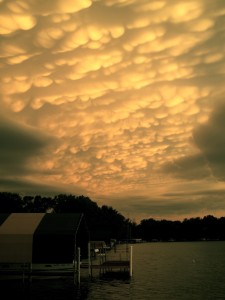
This summer was a summer of clouds. At work, on the beach, in the car, I always seemed to have my head raised toward the sky. There’s just something about that sometimes fluffy, sometimes wispy, sometimes doomful stuff above me that leaves me in awe.
My obsession started last fall when I took the weather and climate class in the geography department here at Gustavus. Never considering myself an avid science lover, I was surprised at my interest in learning more about cloud formations and names. It was never difficult to pay attention in class, and I was even tempted to hang up in my room the laminated cloud-identification poster found in the back of the textbook.
But I became even more attracted to the unusual cloud phenomena, such as contrails, lenticular clouds and crepuscular sun rays (those formations you see in the sky on rare occasions). I was amazed at how water droplets could take on such varying shapes and colors. There are clouds that look like UFOs floating over mountains, clouds that look like ocean waves and clouds that look like horseshoes. “How do they do that?” I would ask.
Spring semester came and went, with slightly more attention paid to the skies. I took the occasional photo on my cell phone or commented on the extra-fluffiness of the cumulus outside that day. Nothing too memorable occurred.
Then, in the second week of summer, it happened: just before sunset, I get a text from my father, who, despite the storm that had passed through less than an hour before, is fishing merrily down at the lake.
“Some interesting clouds from at the dock,” it said.
My family had been impressed with my meteorological knowledge and caught on to my new admiration of clouds, and thus, when inspired and able, would inform me of any interesting formations they thought I might want to see.
I ran into the backyard, camera in hand, and looked up through the trees to see the most magnificent and odd-looking spectacle I had ever seen: the mammatocumulus, or mammatus cloud.
Oh, the mammatus cloud! Such a reversal of the normal cloud shape! Rather that puffing upward like a traditional cumulus cloud, mammatus clouds hang down from the sky in small, round pouches. They are indicative of intense storms, hence their occurrence that night in June. It looked as if hundreds of suspended cotton balls had created a grey blanket, so low I felt at any second they would burst and raindrops would pour down again.
I ran down the cement steps to the dock and was even more amazed. Between the strange color the sky gets post-storm coupled with the setting sun, the water and these unusual clouds, it was truly like nothing I had ever witnessed before.
I believe my cloud observation became, and still is, a form of escape for me. Clouds don’t often appear out of nowhere; rather, they develop, travel across skies, change, redirect, tumble, spread, flatten and dissolve. They have a history and a future, and when I look at them from where I am standing, I am only seeing them in that one moment, that one shape.
Where are they going? Where have they been?
Watching clouds reminds me that there are other moments in the world outside of the present. That though I may be unhappy, frustrated, or anxious, there is no reason for me to stay that way, no reason that I will not in the future be happy like I have been in moments past. My moment becomes part of that cloud-moment, ephemeral yet beautiful, high above but no less intimate.
Take a look at the sky. What moment will you share with the clouds?